Dunkirk: between England and France
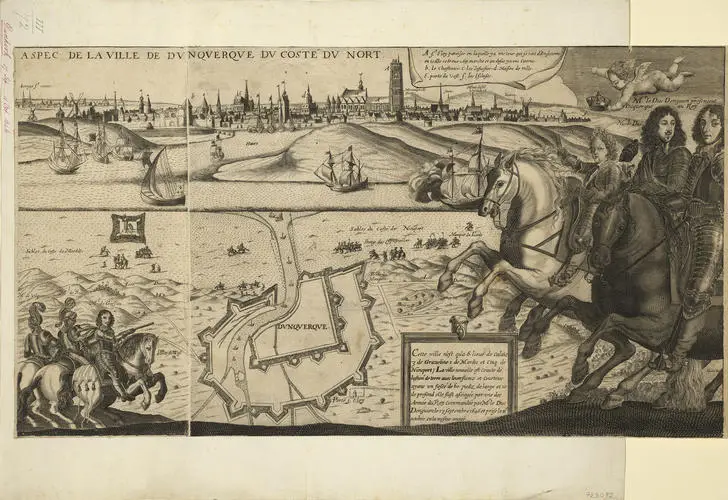
Siege of Dunkirk by the Prince of Condé in 1646.
On September 17, 1646, French troops under the command of Louis II de Bourbon, Prince of Condé besieged Dunkirk, hated by the French and English, the fortress was blocked from the sea by the Dutch fleet of Martin Tromp, and on October 11 the city capitulated.
French Dunkirk, first attempt
The remnants of the Dunkirk privateers took refuge in Spanish Ostend; in 1649 there were 21 of them, and in 1650 their number reached 31. Cardinal Giulio Mazarin appointed Marshal Jozas Rantzau as governor of Dunkirk with the task of returning the sailors to the city and restoring the fleet there. In December 1646, Rear Admiral of France Abraham Duquesne arrived in the city, and on May 2, 1647, a separate branch of the French admiralty was established in Dunkirk.
At the same time, ships purchased in Sweden for the French entered the city. fleet. Duquesne became the commander of the Dunkirk flotilla, but he did not command for long - already in August 1647 he was transferred to the Mediterranean Sea, where he covered himself with glory in 1648-1649.
Well, the French Dunkirk flotilla eked out a miserable existence. However, a holy place is never empty - the Dunkirkers in the English Channel were replaced by Spanish privateers from Ostend and English privateers. In addition, in 1651, the Spaniards launched another offensive in Flanders, and from the sea Dunkirk blocked the 14th frigate of the Spanish captain Jean de Bock, the garrison of Dunkirk experienced great difficulties with supplies, and the new governor Count de Estrade generally proposed in letters to Mazarin to give Dunkirk to England.
On January 30, 1652, de Estrad wrote to Le Tellier that “The enemy is preparing eleven frigates at Ostend”. On April 14, 25 Flemish frigates took part in the Spanish attack on Fort Mardik. After Estrada's call for help, the Duke of Vendôme, admiral of the French fleet, was ordered to leave Brest with his squadron to go to the aid of the besieged Dunkirk, but first he had to confront the Spanish fleet cruising in front of the Ile de Ré, off La Rochelle. Vendôme defeated the Spanish on 9 August, but did not leave La Rochelle until 29 August and did not arrive in Dieppe until 11 September.
At the same time, the Duke of Aumont prepared a small relief fleet in Calais and collected 1 soldiers, but on September 500, 13, Dunkirk capitulated and became Spanish again.
Once again under Spanish rule
It is clear that the liberated Dunkirk immediately became a base for Spanish privateers who had transferred from Ostend.
Archduke Leopold Wilhelm found the city's population depleted by famine. He appointed the Marquis of Lede as governor and immediately reorganized the old composition of aldermen and admiralty. Fort Mardik was rebuilt. On May 28, 1654, an explosion of ammunition stored in the cellars of the castle of Gravelines destroyed most of the houses in the city.
Having stopped hostilities against Holland, but continuing with France, the corsairs of Ostend returned to Dunkirk. They captured fishing boats in Boulogne and Calais, but mediocre catches forced them to sail to the Bay of Biscay. Cabotage also resumed. The Archduke allowed Dunkirk merchants to levy a 1,5% convoy duty on goods to pay for the escort frigates. The armada, commanded by Mathieu Mays, was again based in the port. First a carpenter, then a pilot, he distinguished himself in the Vlissingen expedition.

View of Dunkirk and the harbour.
Spanish military action against England resumed in 1655. In May 1656, seven corsairs from Dunkirk and five from Ostend captured 20 English ships. At the end of June, a division of seven corsairs from Dunkirk and six from Ostend captured 70 coastal ships, mainly coal carriers, thereby paralyzing the work of the port of Newcastle.
In response, twelve English frigates set up a blockade of Dunkirk, but were scattered by autumn storms. Despite Cromwell's dispatch of Montagu's fleet, Spanish privateers captured many ships laden with coal worth 400 guilders in the autumn, as well as a 000-gun escort frigate.
In total, from 1651 to 1660, Flemish privateers captured 981 French ships worth 2 florins and 117 English ships worth 000 florins. 572 was a particularly difficult year for English and French maritime trade.
As for land military operations, 1655 was marked by a brilliant campaign in Flanders with the capture of Landrecie by the Prince of Condé, who went over to the side of the Spaniards (the Fronde was then in full swing in France) and the victory at Saint-Ghislain. The governor of Péronne, Charles de Monchy, Marquis d'Aucincourt, seemed ready to join Condé, but Mazarin paid him 600 livres to prevent him from betraying.
At sea, French trade in the eastern English Channel suffered fewer losses in 1653 than in the previous year, but they remained at a very high level. Also from the summer of 1654, Mazarin welcomed the proposed alliance between France and England. The minister knew how much Cromwell was hated in France, but saw no other way to recapture the cities of Pas-de-Calais-Nord from Philip IV.
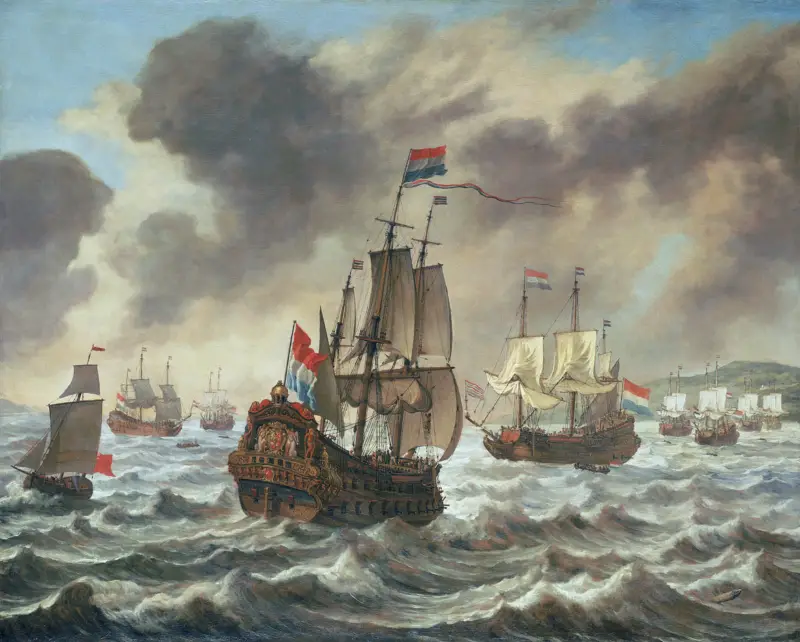
Dutch ships in the English Channel.
In November 1655, the two countries entered into a trade agreement. Cromwell tried to organize a naval blockade of Dunkirk and Ostend in 1656 and 1657, after which a number of Flemish privateers sold their spoils in Cadiz and Vigo. Faced with the success of the corsairs, Cromwell and Mazarin signed the Treaty of Paris on March 3, 1657, and decided to jointly resume the offensive in maritime Flanders.
England pledged to provide 40 ships and 6 men, France - 000 soldiers for the siege of Gravelines, Mardick and Dunkirk. If successful, it was assumed that Gravelines would be given to France, and Mardick and Dunkirk to England.
On June 14, 1658, Turren defeated the Spanish at the Battle of the Dunes and Dunkirk fell. According to the treaty, it was transferred to England.
English Dunkirk
The first English governor of Dunkirk was the Scottish warrior and diplomat William Lockhart of Leigh. He described Dunkirk as a city completely devastated by the war, with only 4 inhabitants remaining. Actually, this became the main problem - the devastated city could not pay taxes, from which the salaries of the English garrison were paid, and quickly became a burden for the English government.
In addition, Oliver Cromwell died, his son Richard was unable to rule the country. The garrison of Dunkirk and the governor sided with Parliament, and on 11 December 1659 Lockhart assured General George Monck of his loyalty. The latter, at the head of an army of Scots and royalists, took London and formed a new parliament.
At this very time, the future king of England, Charles II Stuart, sought to return to England and asked Lockhart to receive him in Dunkirk and ensure his passage to England. Lockhart refused, and the future king settled in Breda, from where he wrote a declaration to parliament. This announcement was greeted with enthusiasm in England, and on May 31 the new chief magistrate of Dunkirk, Thomas Sergeant, declared Charles II his overlord. The next day Charles entered the city and set out for London on 4 June. Lockhart was replaced by Colonel Hardley.
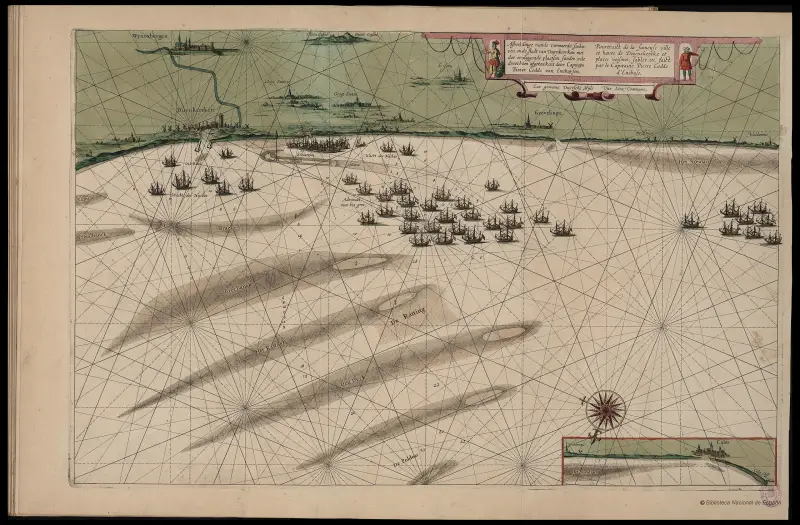
Dunkirk and its flotilla in 1640.
However, the change in the places of the terms did not change the situation in Dunkirk; he still continued to be a burden for England. The Englishman John Grenhal described the condition of Fort Mardik as follows:
The census, commissioned by Lockhart, counted 30 women, 1659 men, and 1 children on July 621, 1.
This is not to say that the British did not try to do anything; for example, they replaced the wooden Fort Leon with a stone citadel. But at the same time, the port piers were never restored, the fairway was not cleared, and as a result, the Dunkirk canal was completely silted, and “ships with a displacement of 300 to 400 tons could enter it only once every two weeks during the big tide."
Many sailors and shipowners, hostile to the British, left for Ostend back in 1658. On September 20, 1660, when the King of England announced the cessation of hostilities with Spain, the last crews of the corsairs crossed to Holland or even to Spain, where the war against Portugal continued.
The maintenance of the royal court, fleet, Jamaican and Dunkirk squadrons exceeded the income of the British crown. Charles II, on the advice of his chancellor Hyde de Clarendon, decided to sell Dunkirk. After long and exhausting negotiations, the price was reduced from 12 to 5 million Turkish livres.
On October 27, 1662, Dunkirk, its citadel and territory came under French control. Louis XIV solemnly entered the city on December 2. That same year, the budget of the French navy was 3 million livres; it further increased to 6,5 million in 1665 and to 10,5 million in 1666.
Thus, the purchase of Dunkirk amounted to a sum approximately equal to six months of the average budget of the French fleet in 1660–1670.
Dunkirk is French again
Strangely enough, Holland rejoiced most of all at the transition of Dunkirk to French jurisdiction. At that time, Holland was an ally of France and believed that it had now gotten rid of the Dunkirk corsairs forever. As they say, I wish I knew in advance...
Representatives of the French administration who arrived in Dunkirk stated that the port was “in poor condition and in great ruin.” However, simultaneously with the signing of the Treaty of Paris, Colbert wrote to Chatillon, the intendant of the fortifications of Dunkirk, that he was awaiting the arrival of an engineer from Amsterdam and that both of them should determine
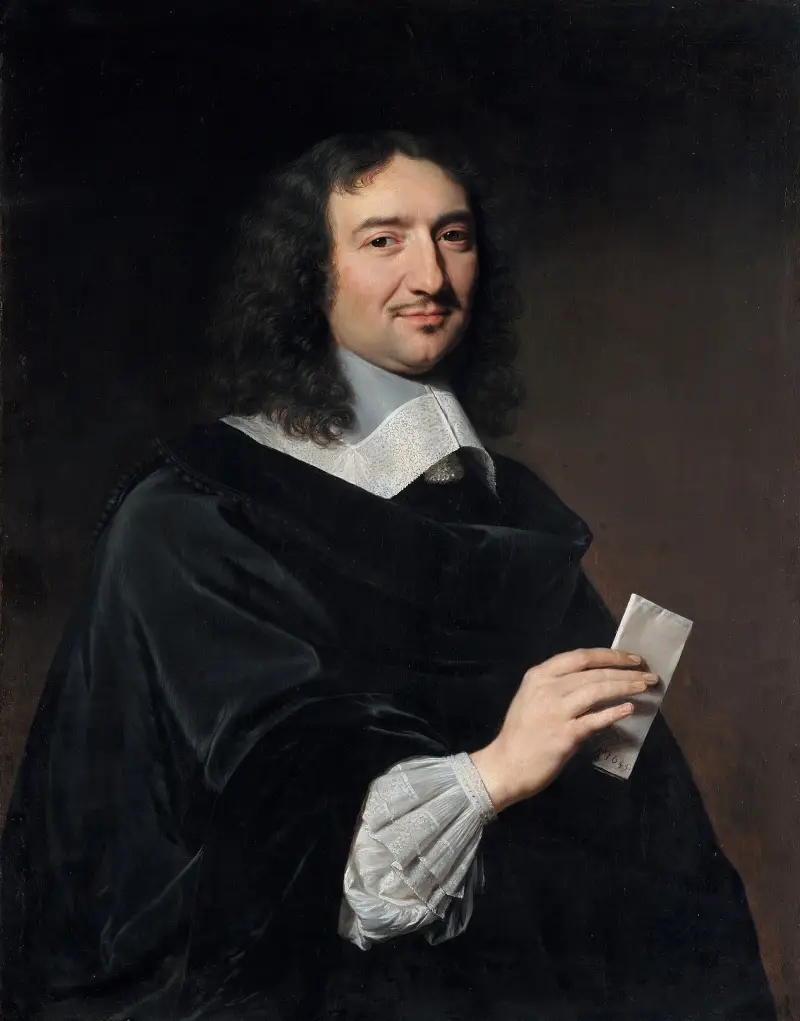
Jean-Baptiste Colbert.
The following year, Colbert commissioned a commission of experts, consisting of the intendant de Terron, the engineer Clairville, the commissary general of the fortifications of Chastillon and the Dutchman Janssen, the architect Blondel and ship captains, to analyze the entire French coastline in the English Channel. The commission noted that Calais and Boulogne could not become naval arsenals. On the other hand, Dunkirk, due to the exclusivity of its harbor, may well, for its harbor, located “a league from the city, can accommodate 500 or more ships.” However, the port and access to it were very bad:
Since Dunkirk was administratively annexed to Picardy, the Deputy Intendant of Picardy was both Commissary General of the Navy and Lieutenant General of the Admiralty. In the autumn of 1662, Louis XIV appointed Nacard as intendant of the Dunkirk fleet.
And from 1661, normal maritime life resumed in Dunkirk.
In the "Inventory of Ships at Dunkirk for 1664" there were 75 ships from 10 to 30 tons, 7 from 30 to 80, 1 from 100, 3 from 100 to 200, and 1 from 240 tons, for a total of 2 tons. Belanders and fishing boats made up the majority of the 675 vessels under 75 tons.
There was only one Dunkirker on the list of captains: Jacob-Janssen Couvenard, a military captain, the rest of the listed natives of the city were merchant captains - Jean Hawkers, Jacob Bahr, Francois Janssen, Balthasar Kerlinck and Jacob Rogier. The large number of owners of fishing fleets can be explained by a measure taken in favor of the city.
At one time, de Estrade informed the sailors of Dunkirk that the fishing vessel would receive 600 livres a year. In addition, the inhabitants of Dunkirk were exempted from serving on French warships. The inhabitants of Dordrecht and Gertrudenberg settled in exchange for a monopoly on salmon fishing from Nieuport to Gravelines and exemption from the soldiers' quarters. In a border town this privilege was significant.
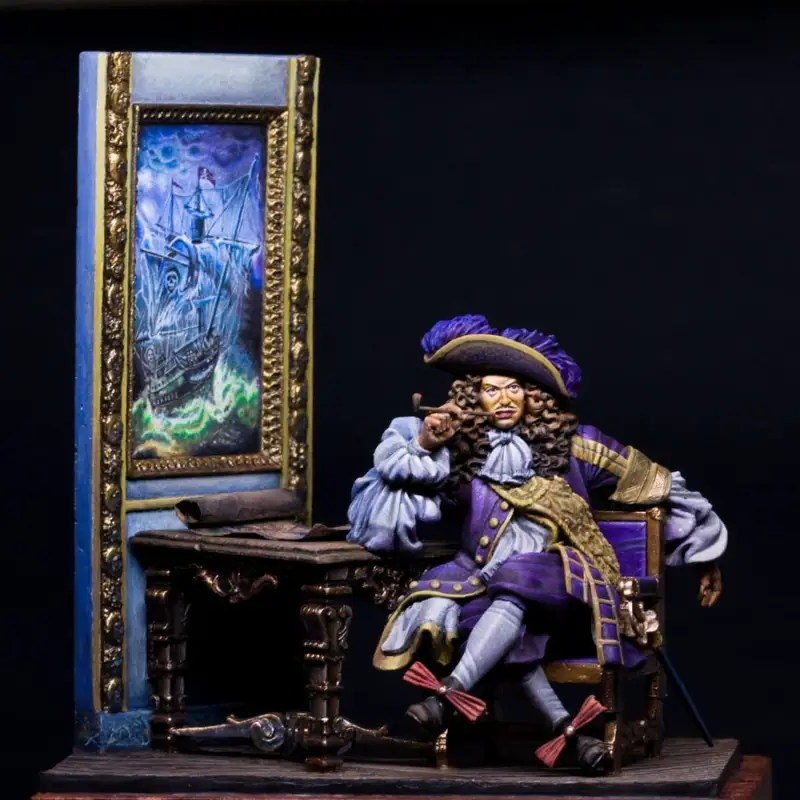
The most famous corsair of French Dunkirk is Jean Bart.
In January 1663, the city could accommodate up to 1 soldiers. However, Nakkar built new barracks as it was necessary to accommodate the 800 companies of the garrison.
Thus, all the inhabitants of Dunkirk were gradually exempted from the quartering of troops, with the exception of the quartering of officers in local hotels.
The city and port began to be dressed in stone, the stones were delivered from the Boulogne quarries by sea.
Well, March 31, 1665
Actually, this day is the date of the creation of the French Dunkirk flotilla, which so loudly declared itself in subsequent wars.
References:
1. Patrick Villiers “Les corsaires du littoral: Dunkerque, Calais, Boulogne, de Philippe II à Louis XIV (1568–1713)” – Presses Universitaires du Septentrion, 2000.
2. Colin Martin, Geoffrey Parker “The Spanish Armada” – Manchester Univ Pr., 2002.
3. EW Petrejus “La flûte hollandaise” – Lausanne, 1967.
4. Unger, Richard W. “Dutch Shipbuilding in the Golden Age” – History Today. Vol. 34, No. 1, 1981.
5. H. Malo “Les corsaires dunkerquois et Jean Bart”, volume I – Des origines à 1682. Paris, Mercure de France, 1913.
6. Dr Lemaire, “La frégate, navire dunkerquois” – Bulletin de l'Union Faulconnier, tome XXX, 1933.
7. La Roncière “Histoire de la marine française”, tome IV – Revue d'Histoire Moderne & Contemporaine Année, 1910.
Information